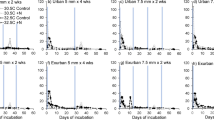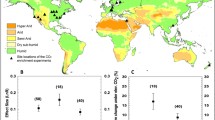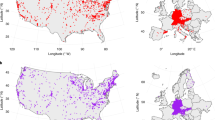Abstract
To examine the impact of climate change on vegetative productivity, we exposed fallow agricultural soil to an in situ temperature and CO2 gradient between urban, suburban and rural areas in 2002. Along the gradient, average daytime CO2 concentration increased by 21% and maximum (daytime) and minimum (nighttime) daily temperatures increased by 1.6 and 3.3°C, respectively in an urban relative to a rural location. Consistent location differences in soil temperature were also ascertained. No other consistent differences in meteorological variables (e.g. wind speed, humidity, PAR, tropospheric ozone) as a function of urbanization were documented. The urban-induced environmental changes that were observed were consistent with most short-term (~50 year) global change scenarios regarding CO2 concentration and air temperature. Productivity, determined as final above-ground biomass, and maximum plant height were positively affected by daytime and soil temperatures as well as enhanced [CO2], increasing 60 and 115% for the suburban and urban sites, respectively, relative to the rural site. While long-term data are needed, these initial results suggest that urban environments may act as a reasonable surrogate for investigating future climatic change in vegetative communities.
Similar content being viewed by others
References
Cooper JP (1970) Potential production and energy conversion in temperate and tropical grasses. Herb Abstr 40:1–15
Cure JD, Acock B (1986) Crop responses to carbon dioxide doubling: a literature survey. Agric For Meteorol 38:127–145
DeLucia EH, Sasek TW, Strain BR (1985) Photosynthetic inhibition after long-term exposure to elevated levels of atmospheric carbon dioxide. Photosynth Res 7:175–184
DeLucia EH, Hamilton JG, Naidu SL, Thomas RB, Andres JA, Finzi A, Lavine M, Matamala R, Mohan JE, Hendrey GR, Schlesinger WH (1999) Net primary production of a forest ecosystem with experimental CO2 enrichment. Science 284:1177–1179
DiCagno R, Guidi L, DeGara L, Soldatini GF (2001) Combined cadmium and ozone treatments affect photosynthesis and ascorbate-dependent defences in sunflower. New Phytol 151:627–636
Edwards GR, Clark H, Newton PCD (2001) The effects of elevated CO2 on seed production and seedling recruitment in a sheep-grazed pasture. Oecologia 127:383–394
Endress GA, Endress AG, Iverson LR (1999) Drought and ozone stress effects on competition among selected prairie grass species and giant foxtail. HortTechnology 9:227–234
Kimball BA, Mauney JR, Nakayama FS, Idso SB (1993) Effects of increasing atmospheric CO2 on vegetation. Vegetatio 104/105:65–75
Krupa SV, Kickert RN (1997) Considerations for establishing relationships between ambient ozone (O3) and adverse crop response. Environ Rev 5:55–77
Krupa SV, Manning WJ (1988) Atmospheric ozone: Formation and effects on vegetation. Environ Pollut 50:101–137
Kukla G, Karl TR (1993) Night-time warming and the greenhouse effect. Environmental Science and Technology 27:1468–1474
LaDeau SL, Clark JS (2001) Rising CO2 levels and the fecundity of forest trees. Science 292:95–98
McCarthy JJ, Canzian, OF, Leary NA, Dokken DJ, White KS (2001) Climate change 2001: impacts, adaptation, and vulnerability. Cambridge University Press, Cambridge, UK
Morgan JA, LeCain DR, Mosier AR, Milchunas DG (2001) Elevated CO2 enhances water relations and productivity and affects gas exchange in C3 and C4 grasses of the Colorado shortgrass steppe. Global Change Biol 7:451–466
Reich PB, Knops J, Tilman D, Craine J, Ellsworth D, Tjoelker M, Lee T, Wedin D, Naeem S, Bahauddin D, Hendrey G, Jose S, Wrage K, Goth J, Bengston W (2001) Plant diversity enhances ecosystem responses to elevated CO2 and nitrogen deposition. Nature 410:809–812
Schimel D, Alves D, Enting I, Heimann M, Joos F, Raynaud D, Wigley T, Prather M, Der Went R, Ehhalt D, Fraser P, Sanhueze E, Zhou X, Jonas P, Charlson R, Rodhe H, Sadasivan S, Shine KP, Fouquart Y, Ramasawamy V, Solomon S, Srinivasan J, Albritton D, DerWent R, Isaksen I, Lal M, Wuebbles D. (1996) Radiative forcing of climate change. In: Houghton JT, Meira-Filho LG, Callander BA, Harris N, Kattenberg A, Maskell K (eds) Climate change 1995: the science of climate change. Cambridge University Press, Cambridge, UK, 65–131
Stitt M (1991) Rising CO2 levels and their potential significance for carbon flow in photosynthetic cells. Plant Cell Environ 14:741–762
Volin JC, Reich PB, Givnish TJ (1998) Elevated carbon dioxide ameliorates the effects of ozone on photosynthesis and growth: species respond similarly regardless of photosynthetic pathway or plant functional group. New Phytol 138:315–325
Ziska LH (2002) Sensitivity of ragweed (Ambrosia artemisiifolia) growth to urban ozone concentrations. Funct Plant Biol 29:1365–1369
Ziska LH, Gebhard DE, Frenz DA, Faulkner SS, Singer BD, Straka JG (2003) Cities as harbingers of climate change: Common ragweed, urbanization, and public health. J Allergy Clin Immunol 111:290–295
Acknowledgements
This research was supported by the Biological and Environmental Research Program (BER), U.S. Department of Energy, Interagency Agreement No. DE-AI02–02ER63360 to L.H.Z. and J.A.B.
Author information
Authors and Affiliations
Corresponding author
Rights and permissions
About this article
Cite this article
Ziska, L.H., Bunce, J.A. & Goins, E.W. Characterization of an urban-rural CO2/temperature gradient and associated changes in initial plant productivity during secondary succession. Oecologia 139, 454–458 (2004). https://doi.org/10.1007/s00442-004-1526-2
Received:
Accepted:
Published:
Issue Date:
DOI: https://doi.org/10.1007/s00442-004-1526-2




